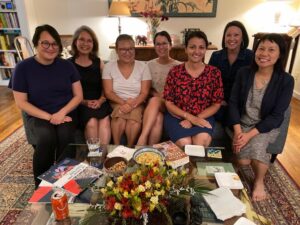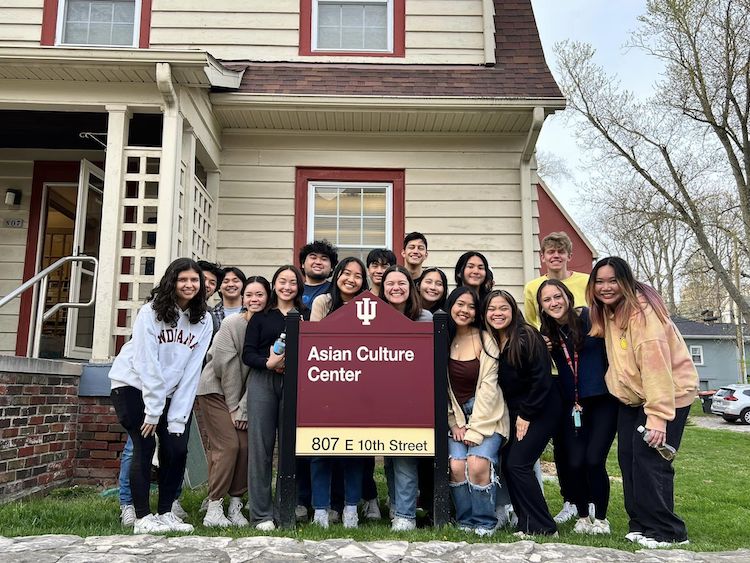By Rong Xiaoqing. Ethnic Media Services.
Indiana AAPI Americans say an attack on a Chinese student in Bloomington earlier this year created a stronger sense of solidarity within the community.

Anne Watkins says the January 11 stabbing of an 18-year-old Chinese-American student allegedly by Billie Davis, 56, who is white, fundamentally changed her perception of the city she calls home.
“When it happened in Bloomington, I thought: They are one step closer,” says Watkins, a Taiwanese-American and recent graduate of nearby Indiana University. Watkins currently works as an assistant manager at a Starbucks on the Bloomington college campus.
But for Katherin Chi, an Indiana-born Chinese-American and IU alumnus, the attack came as no surprise. Chi, an active member of the Indiana chapter of the National Asian-Pacific American Women's Forum (NAPAWF), witnessed the rise of anti-Asian hatred across the country and warned Bloomington officials and residents of the impending danger.
"That was our biggest fear," Chi says, recalling the unprovoked attack at a local bus stop.
Davis allegedly told investigators that he stabbed the victim because she was Chinese, saying he would "be one less person to blow up our country," according to the police affidavit. The victim survived the attack. His family has requested that he remain anonymous out of fear for his safety.
A federal grand jury decided in April to indict Davis on one count of hate crime. The victim and her family have not spoken publicly about the incident and declined interview requests for this article. Davis' son, for his part, told local media that his mother has a mental illness.

The silence that followed around the case worried Watkins. "I felt like it was a hot topic in Bloomington for two or three days, and then it just went away."
However, for members of Indiana's growing API community, lingering anxiety and fear remain. For some, the attack was a wake-up call that had been long in the making.
'That could have been me'
“I thought I was white before I was 30,” says Michelle Waugh-Dahl, a Korean adoptee who grew up in Franklin, an hour north of Bloomington. It wasn't until 2016 and the election of Donald Trump that Waugh-Dahl began to have doubts about his own identity and broader issues of race and equity.
He began distributing food outside his home, then joined Black Lives Matter protests and painted slogans in support of the movement in his front yard. Friends were confused, some began to reject her. But for Waugh-Dahl, the attack taught him an unsettling lesson: "That could have been me on the bus."
Indiana's API community has nearly doubled in size since 2010 to more than 191,000, representing 2.8 percent of the state's overall population. And while there are about 150 organizations providing API services across the state, according to a study by the Asian American Alliance Inc., which focuses on empowering Asian American business and civic leadership, most have focused primarily on cultural promotion. and social services. Then came NAPAWF Indiana.
Founded in 2020, the group advocates for API women and is a fierce advocate for social justice issues. His arrival in Bloomington couldn't have come at a more critical time, as attacks targeting Asian Americans that same year increased by as much as 145 percent in cities across the country, according to data from the Center for the Study of Hate. and California Extremism. State University, San Bernardino.
While the data for Indiana does not identify a specific race or ethnicity, the US Department of Justice found 87 incidents of attacks motivated by ?race, ethnicity, or ancestry? in 2021, twice as much as two years before.

Meanwhile, Asian Americans in the state say the atmosphere has grown noticeably more hostile, citing a number of incidents, including the 2021 mass shooting that killed eight people, including four Sikh employees at a FedEx facility in Indianapolis, where most of the employees are Sikh. This year, Northwestern Purdue University Chancellor Thomas Keon was caught on tape mocking Asian languages during a commencement address.
Even in more liberal Bloomington, API residents say they've seen an increasing number of vehicles flying the Confederate flag, while a 2019 clash between activist groups and white nationalists at a local farmers' market grabbed national headlines. .
For NAPAWF co-chair Melissa Borja, at the time of the stabbing in January, “we were already exhausted, it's not sustainable to continually react. Do we have to network with other AAPI people in Indiana before an event happens?
But Borja and other NAPAWF members point out that it's not even clear where Asian-Americans are in Indiana. “We need to proactively create spaces to network, organize and build solidarity.”
past as predicate
That sense of solidarity was evident during a rally in Indiana following a 2021 shooting that killed seven women, six of them Asian-American, in Atlanta. Rupal Thanawala, president of the advocacy group Asian American Alliance, says she expected perhaps two dozen people to show up that day. Instead, more than 200 people attended, making it the largest such protest by Asian-American residents in the state.
"Chinese, Korean, Indian, Burmese organizations, we all came together," recalls Thanawala.
That same month, NAPAWF Indiana delivered a petition signed by more than 2,700 people and 49 local organizations to Republican Governor Eric Holcomb asking him to address violence against Asians.

Kwan Hui came to Indiana 34 years ago. Today he serves as president of the Indiana Association of Chinese Americans, which he says since its inception in 1973 has focused primarily on cultural promotion. But, he adds, "society is changing...we have added racial discrimination to our watch list."
Hui, a retired researcher for drugmaker Eli Lilly, says that until recently, API organizations in Indiana were largely secretive. That has now begun to change in response to rising anti-Asian hatred, which Hui says has prompted the groups to work together.
“The person who stabbed the IU student didn't care if you were Chinese or not. This goes against all Asians?.
An uphill battle
In a state where 84 percent of residents are white, arguing for stronger protections for APIs and other minority groups can be daunting.
While the Indiana Democratic Party has an African American Caucus and a Latino Caucus, there is no such caucus for the API community. There is also no legislative commission on API issues similar to the commissions on Black, Latino, and Native American issues.
In its most recent petition sent to Governor Holcomb earlier this year, NAPAWF urged the state to establish a statewide advisory committee on AAPI matters. So far there has been no response. (The Governor's office did not respond to questions from this reporter.)
Meanwhile, legal tools to fight discrimination are often non-existent.
Until recently, Indiana was among a small number of states that did not have a hate crime law. That changed in 2019, when Indiana finally passed a bill creating hate crime legislation for the first time in the state.
But critics say the bill's language about protecting specific groups is so vague that it almost makes no sense. An analysis by the Brennan Center for Justice in 2020 still listed Indiana as one of five states without a hate crime law because it "fails to list protected classes."
Moving forward to face the hate
For many members of the API community, filing a complaint may not be an option, says Randy Diaz, immigrant outreach specialist with the Indianapolis Metropolitan Police Department. Immigrants ?may not feel comfortable talking to a police officer,? Díaz explains, citing immigration status and language barriers as some of the reasons for this reluctance.
Diaz says the absence of hate crime legislation in the state leaves her hands tied. "When a hate crime is committed against someone...because we don't have (a hate crime code), it's hard to report it," Diaz said. "I can't arrest you for something that doesn't exist."

Others say the solution lies in the ballot box and in greater political participation by API communities. ?How many (Asians) want to run for office?? asked Thanawala of the Asian American Alliance. “I want people in my community to be part of the system.”
In 2020, NAPAWF Indiana launched a voter mobilization campaign in multiple Asian languages. The organization plans to replicate the operation in future elections.
In May, Shruti Rana, associate dean and professor of international law and human rights at Indiana University Bloomington and co-founder of NAPAWF Indiana won a primary to become the Democratic nominee for city council, a seat she is likely to win given there are no there are no Republican candidates in your district.
“We don't have the option of turning around and pretending there's no such thing as discrimination, or there's no such thing as racial prejudice, or there's no such thing as gender discrimination,” Rana said. “These are issues that matter to us and that we are going to address.”
At the Asian Cultural Center on IU's Bloomington campus, Principal Melanie Castillo-Cullather is gearing up for the new semester on a scorching day in early August. Under his leadership, his center became the command center for Bloomington's Asian-American community to address their fears after the stabbing. He knows the trauma of the stabbing will still be with the students when they return for the fall semester. While you can't offer updates on the case or the victim, you can offer something else.
"Let's give her and her family some space and time," says Castillo-Cullather, who is also a founding member of NAPAWF. “When the survivor is ready, she knows that we are here and that we have her back. Here is an Asian-American community?.
This story was produced in association with the Vincent Chin Institute as part of a series looking at the long-term impacts of hate on communities in California and across the country. The Chinese original appeared in the pages of the Sing Tao Daily New York.


This publication was supported in whole or part by funding provided by the State of California, ayou administeredred by the CaliFornia State Library.

You may be interested in: Racism: main motivator of attack in Jacksonville that left three people dead


